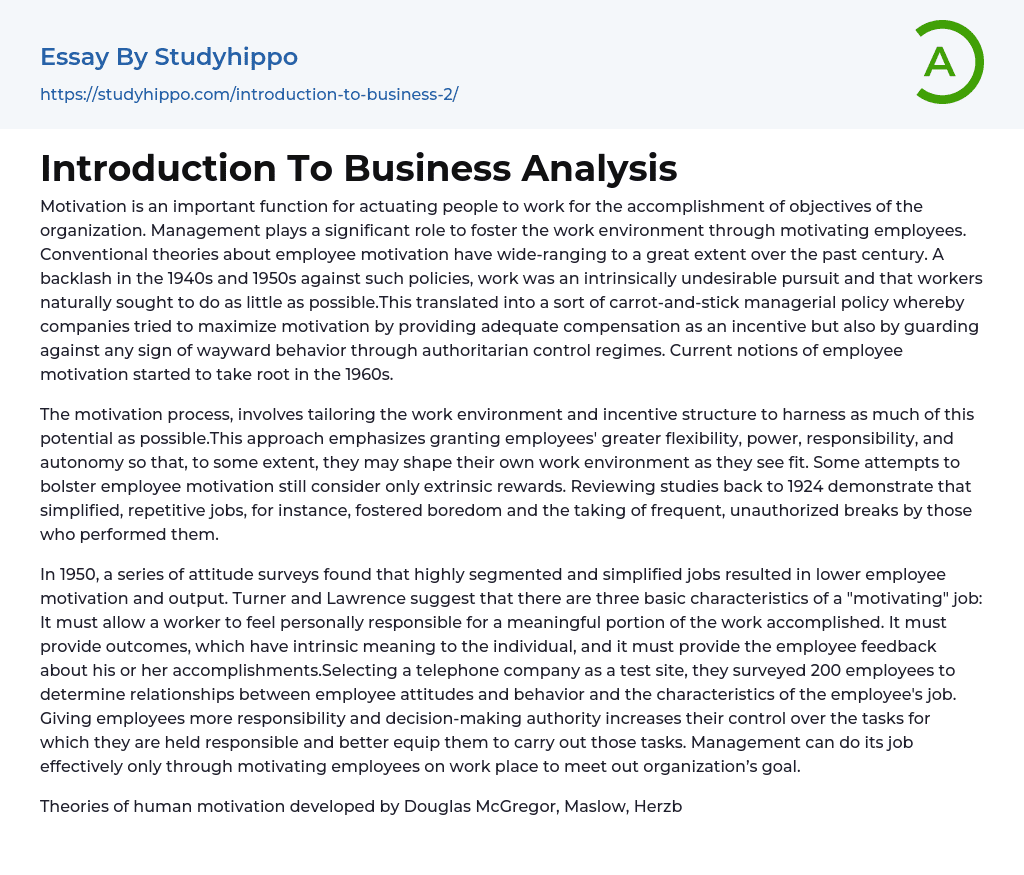The role of the management team in creating a work environment that fosters employee motivation is crucial for achieving organizational goals. The concept of employee motivation has evolved over time, with conventional theories and practices changing significantly. In the 1940s and 1950s, there was a shift away from policies that treated work as inherently undesirable, which led to companies using compensation as an incentive and authoritarian measures to prevent deviation from desired behavior (carrot-and-stick approach). However, new ideas about employee motivation emerged in the 1960s.
The process of motivating employees involves customizing the work environment and incentive structure to utilize their potential to the fullest. This strategy prioritizes providing employees with more flexibility, responsibility, autonomy, and power to shape their work environment as they deem fit. However, certain efforts made to increase employee motivation solely focus on prov
...iding external rewards. Research studies dating back to 1924 indicate that monotonous and repetitive tasks lead to boredom and frequent unauthorized breaks by workers who undertake them.
Back in 1950, a series of surveys showed that jobs that were oversimplified and fragmented led to decreased motivation and output in employees. Turner and Lawrence later identified three key features of a job that would boost motivation: workers should be personally responsible for a significant part of the work, outcomes should hold intrinsic significance for workers, and employees should receive feedback on their performance. In order to determine the relationship between employee job characteristics and behavior, they surveyed 200 telephone company employees. It was found that providing employees with more decision-making authority and responsibility increased their control over tasks and improved their ability to complete them effectively. Ultimately, only by motivating employees
can management effectively guide an organization towards reaching its goals.
Theories of human motivation, including those developed by Douglas McGregor, Maslow, Herzberg, and Vroom, emphasize that understanding motivation requires considering what individuals desire and anticipate from their work. McGregor proposed two divergent theories of human behavior, labeled Theory X and Theory Y. These theories involve two sets of assumptions regarding employees, which are influenced by autocratic and permissive managerial actions. Theory X reflects traditional approaches to managerial motivation and control, whereas Theory Y assumes that individuals are not inherently untrustworthy or indolent.
My belief is that Theory Y is the most plausible approach. It entails that with adequate motivation, employees can be highly innovative. The primary objective of management is to extract the full capacity of the workforce. The theory assumes that mental and physical work are sources of employee satisfaction. By allowing employees the freedom to excel, there is a possibility of achieving higher productivity.
McGregor's work was centered around Maslow's hierarchy of needs, which he categorized into two sets: "lower order" needs (Theory X) and "higher order" needs (Theory Y). McGregor suggested that while management could use either set of needs to motivate employees, better results would be achieved by fulfilling the Theory Y needs. Herzberg, who was closely associated with Maslow, promoted a theory of motivation that focused on two factors. He believed that businesses could introduce specific factors (Motivators) to directly stimulate employees to work harder by enhancing the nature and content of the job through methods like Job Enlargement, Job Enrichment, and Empowerment.
For the past two decades, behavioral research has consistently discovered different factors that affect how people approach their work and
how this affects their accomplishments. These findings not only shed light on previous studies but also offer potential areas for future research. Saul W. Gellerman's motivation theory, which was introduced in 1968, aims to clarify these implications. McGregor's 'Y' theory is also a catalyst for positive management practices, organizational development, and improving overall organizational culture.
References: 1) Herzberg. F. (1968). "One More Time: How Do You Motivate Employees?" Harvard Business Review, January-February.
2) The book "Ultimate Rewards: What Really Motivates People to Achieve" was written by Steven Kerr in 1997 and published in Boston by Harvard Business School. 3) Another author in the field is Richard M. Steers, along with Lyman W.
6th Edition of the book "Motivation and Leadership at Work" by Porter and Gregory A. Bigley published in 1996.
The American Management Association published "Management by Motivation" by Saul W. Gellerman in 1968 through McGraw-Hill in New York. (4)
Location of Publication: New York and the specific publication and page number is 27.
- Business Analysis essays
- Business Plan essays
- Community Development essays
- Competition essays
- Effective Leadership essays
- Leadership Styles essays
- Mission Statement essays
- Negotiation essays
- Outsourcing essays
- Planning essays
- Public relations essays
- Reasoning essays
- Strategic Management essays
- Strategic Planning essays
- Swot Analysis essays
- Bias essays
- Big Five Personality Traits essays
- Body Image essays
- Mind essays
- Motivation essays
- Phobias essays
- Thought essays
- Code of Ethics essays
- Conflict essays
- Dress Code essays
- Human Resources essays
- Organizational Behavior essays
- Performance essays
- Recruitment essays
- Safety essays




